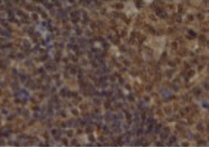ARG56593
anti-RANTES antibody [5B3.D5]
anti-RANTES antibody [5B3.D5] for ELISA,IHC-Formalin-fixed paraffin-embedded sections,Neutralizing,Western blot and Human
Overview
| Product Description | Mouse Monoclonal antibody [5B3.D5] recognizes RANTES |
|---|---|
| Tested Reactivity | Hu |
| Tested Application | ELISA, IHC-P, Neut, WB |
| Host | Mouse |
| Clonality | Monoclonal |
| Clone | 5B3.D5 |
| Isotype | IgG2b, kappa |
| Target Name | RANTES |
| Antigen Species | Human |
| Immunogen | E.coli derived Recombinant Human RANTES. (SPYSSDTTPC CFAYIARPLP RAHIKEYFYT SGKCSNPAVV FVTRKNRQVC ANPEKKWVRE YINSLEMS) |
| Conjugation | Un-conjugated |
| Alternate Names | 3-68; C-C motif chemokine 5; SIS-delta; D17S136E; SISd; T cell-specific protein P228; EoCP; Small-inducible cytokine A5; Eosinophil chemotactic cytokine; TCP228; 4-68; RANTES; SCYA5; eoCP; T-cell-specific protein RANTES |
Application Instructions
| Application Suggestion |
|
||||||||||
|---|---|---|---|---|---|---|---|---|---|---|---|
| Application Note | * The dilutions indicate recommended starting dilutions and the optimal dilutions or concentrations should be determined by the scientist. |
Properties
| Form | Liquid |
|---|---|
| Purification | Purification with Protein A. |
| Buffer | PBS (pH 7.2) |
| Concentration | 1 mg/ml |
| Storage Instruction | For continuous use, store undiluted antibody at 2-8°C for up to a week. For long-term storage, aliquot and store at -20°C or below. Storage in frost free freezers is not recommended. Avoid repeated freeze/thaw cycles. Suggest spin the vial prior to opening. The antibody solution should be gently mixed before use. |
| Note | For laboratory research only, not for drug, diagnostic or other use. |
Bioinformation
| Database Links | |
|---|---|
| Gene Symbol | CCL5 |
| Gene Full Name | chemokine (C-C motif) ligand 5 |
| Background | This gene is one of several chemokine genes clustered on the q-arm of chromosome 17. Chemokines form a superfamily of secreted proteins involved in immunoregulatory and inflammatory processes. The superfamily is divided into four subfamilies based on the arrangement of the N-terminal cysteine residues of the mature peptide. This chemokine, a member of the CC subfamily, functions as a chemoattractant for blood monocytes, memory T helper cells and eosinophils. It causes the release of histamine from basophils and activates eosinophils. This cytokine is one of the major HIV-suppressive factors produced by CD8+ cells. It functions as one of the natural ligands for the chemokine receptor chemokine (C-C motif) receptor 5 (CCR5), and it suppresses in vitro replication of the R5 strains of HIV-1, which use CCR5 as a coreceptor. Alternative splicing results in multiple transcript variants that encode different isoforms. [provided by RefSeq, Jul 2013] |
| Function | Chemoattractant for blood monocytes, memory T-helper cells and eosinophils. Causes the release of histamine from basophils and activates eosinophils. May activate several chemokine receptors including CCR1, CCR3, CCR4 and CCR5. One of the major HIV-suppressive factors produced by CD8+ T-cells. Recombinant RANTES protein induces a dose-dependent inhibition of different strains of HIV-1, HIV-2, and simian immunodeficiency virus (SIV). The processed form RANTES(3-68) acts as a natural chemotaxis inhibitor and is a more potent inhibitor of HIV-1-infection. The second processed form RANTES(4-68) exhibits reduced chemotactic and HIV-suppressive activity compared with RANTES(1-68) and RANTES(3-68) and is generated by an unidentified enzyme associated with monocytes and neutrophils. May also be an agonist of the G protein-coupled receptor GPR75, stimulating inositol trisphosphate production and calcium mobilization through its activation. Together with GPR75, may play a role in neuron survival through activation of a downstream signaling pathway involving the PI3, Akt and MAP kinases. By activating GPR75 may also play a role in insulin secretion by islet cells. [UniProt] |
| Highlight | Related products: RANTES antibodies; RANTES ELISA Kits; Anti-Mouse IgG secondary antibodies; Related news: circNDUFB2, a circular RNA (circRNA), activates anti-tumor immunity |
| Calculated MW | 10 kDa |
| PTM | N-terminal processed form RANTES(3-68) is produced by proteolytic cleavage, probably by DPP4, after secretion from peripheral blood leukocytes and cultured sarcoma cells. The identity of the O-linked saccharides at Ser-27 and Ser-28 are not reported in PubMed:1380064. They are assigned by similarity. |
Images (3) Click the Picture to Zoom In
-
ARG56593 anti-RANTES antibody [5B3.D5] IHC-P image
Immunohistochemistry: Formalin-fixed and paraffin-embedded sections of Human tonsil. The recommended ARG56593 anti-RANTES antibody [5B3.D5] concentration is 10.0 µg/ml with an overnight incubation at 4˚C. An HRP-labeled polymer detection system was used with a DAB chromogen. Antigen Retrieval: Boil tissue section in Citrate buffer (pH 6.0) followed by cooling at RT for 20 min.
-
ARG56593 anti-RANTES antibody [5B3.D5] IHC-P image
Immunohistochemistry: Formalin-fixed and paraffin-embedded sections of Human tonsil. The recommended ARG56593 anti-RANTES antibody [5B3.D5] concentration is 10.0 µg/ml with an overnight incubation at 4˚C. An HRP-labeled polymer detection system was used with a DAB chromogen. Antigen Retrieval: Boil tissue section in Citrate buffer (pH 6.0) followed by cooling at RT for 20 min.
-
ARG56593 anti-RANTES antibody [5B3.D5] IHC-P image
Immunohistochemistry: Formalin-fixed and paraffin-embedded sections of Human tonsil. The recommended ARG56593 anti-RANTES antibody [5B3.D5] concentration is 10.0 µg/ml with an overnight incubation at 4˚C. An HRP-labeled polymer detection system was used with a DAB chromogen. Antigen Retrieval: Boil tissue section in Citrate buffer (pH 6.0) followed by cooling at RT for 20 min.








